Prediction Model of Hydropower Generation and Its Economic Benefits Based on EEMD-ADAM-GRU Fusion Model
Abstract
:1. Introduction
2. Methods
2.1. EEMD Model
2.2. GRU Model
2.3. ADAM Optimization Algorithm
2.4. Construction of Fusion Prediction Model
3. Case Study
4. Conclusions
- (1)
- As an improved RNN neural network, the GRU model can conduct deep mining on the change rule of time series and derive high-precision prediction accuracy on the time series of hydropower generation. EEMD signal decomposition and ADAM model parameter optimization can further improve the prediction accuracy of the GRU model. Compared with the conventional time series prediction model, the average prediction error is reduced by more than 10%.
- (2)
- The economic benefits of hydropower generation measure only the direct economic benefits. In addition, the hydropower price is replaced by the national average hydropower unit price, which does not reflect the fluctuation of hydropower prices with months. It should study the pricing mechanism and fluctuation law of hydropower prices in all provinces of the country in the future, so as to accurately measure the economic benefits of hydropower generation.
- (3)
- The proposed prediction model is based on the concept of the “signal decomposition +parameter optimization+ prediction model”. There are many types of signal decomposition methods and prediction models in existing research results. This paper only selects representative methods to combine and analyze. In future research, it is necessary to expand the model selection and analyze the prediction accuracy of different model combinations to propose a more universal prediction method.
Author Contributions
Funding
Institutional Review Board Statement
Informed Consent Statement
Data Availability Statement
Conflicts of Interest
References
- Lu, X.; Li, C.; Liu, D.; Zhu, Z.; Tan, X. Influence of water diversion system topologies and operation scenarios on the damping characteristics of hydropower units under ultra-low frequency oscillations. Energy 2022, 239, 122679. [Google Scholar] [CrossRef]
- Zhang, S.; Chen, S.-J.; Ma, G.-W.; Huang, W.-B.; Li, B. Generation hybrid forecasting for frequency-modulation hydropower station based on improved EEMD and ANN adaptive switching. Electr. Eng. 2022, 104, 2949–2966. [Google Scholar] [CrossRef]
- Ding, W.; Yu, B.; Peng, Y.; Han, G. Evaluating the Marginal Utility of Two-Stage Hydropower Scheduling. J. Water Resour. Plan. Manag. 2022, 148. [Google Scholar] [CrossRef]
- Li, C.; Lin, T.; Xu, Z. Impact of Hydropower on Air Pollution and Economic Growth in China. Energies 2021, 14, 2812. [Google Scholar] [CrossRef]
- Bello, M.O.; Solarin, S.A.; Yen, Y.Y. Modelling the economic role of hydropower: Evidence from bootstrap autoregressive distributed lag approach. Renew. Energy 2021, 168, 76–84. [Google Scholar] [CrossRef]
- Zhong, W.; Guo, J.; Chen, L.; Zhou, J.; Zhang, J.; Wang, D. Future hydropower generation prediction of large-scale reservoirs in the upper Yangtze River Basin under climate change. J. Hydrol. 2020, 588, 125013. [Google Scholar] [CrossRef]
- Dehghani, M.; Riahi-Madvar, H.; Hooshyaripor, F.; Mosavi, A.; Shamshirband, S.; Zavadskas, E.K.; Chau, K.-w. Prediction of Hydropower Generation Using Grey Wolf Optimization Adaptive Neuro-Fuzzy Inference System. Energies 2019, 12, 289. [Google Scholar] [CrossRef] [Green Version]
- Huangpeng, Q.; Huang, W.; Gholinia, F. Forecast of the hydropower generation under influence of climate change based on RCPs and Developed Crow Search Optimization Algorithm. Energy Rep. 2021, 7, 385–397. [Google Scholar] [CrossRef]
- Yang, S.; Wei, H.; Zhang, L.; Qin, S. Daily Power Generation Forecasting Method for a Group of Small Hydropower Stations Considering the Spatial and Temporal Distribution of Precipitation—South China Case Study. Energies 2021, 14, 4387. [Google Scholar] [CrossRef]
- Lin, B.; Shi, L. New understanding of power generation structure transformation, based on a machine learning predictive model. Sustain. Energy Technol. Assess. 2022, 51, 101962. [Google Scholar] [CrossRef]
- Ikram, R.M.A.; Dai, H.; Ewees, A.A.; Shiri, J.; Kisi, O.; Zounemat-Kermani, M. Application of improved version of multi verse optimizer algorithm for modeling solar radiation. Energy Rep. 2022, 8, 12063–12080. [Google Scholar] [CrossRef]
- Zhang, D.; Wang, D.; Peng, Q.; Lin, J.; Jin, T.; Yang, T.; Sorooshian, S.; Liu, Y. Prediction of the outflow temperature of large-scale hydropower using theory-guided machine learning surrogate models of a high-fidelity hydrodynamics model. J. Hydrol. 2022, 606, 127427. [Google Scholar] [CrossRef]
- Yu, H.; Dai, Q. DWE-IL: A new incremental learning algorithm for non-stationary time series prediction via dynamically weighting ensemble learning. Appl. Intell. 2021, 52, 174–194. [Google Scholar] [CrossRef]
- Mir, A.A.; Celebi, F.V.; Rafique, M.; Faruque, M.R.I.; Khandaker, M.U.; Kearfott, K.J.; Ahmad, P. Anomaly Classification for Earthquake Prediction in Radon Time Series Data Using Stacking and Automatic Anomaly Indication Function. Pure Appl. Geophys. 2021, 178, 1593–1607. [Google Scholar] [CrossRef]
- Yang, H.; Roshan, T.; Zhu, Y.; Kumar, V.; Melton, G.B.; Steinbach, M.; Simon, G. Strategies for building robust prediction models using data unavailable at prediction time. J. Am. Med. Inform. Assoc. 2021, 29, 72–79. [Google Scholar] [CrossRef] [PubMed]
- Zhang, X.; Zhang, Q.; Zhang, G.; Nie, Z.; Gui, Z. A Hybrid Model for Annual Runoff Time Series Forecasting Using Elman Neural Network with Ensemble Empirical Mode Decomposition. Water 2018, 10, 416. [Google Scholar] [CrossRef] [Green Version]
- Li, L.; Yang, Y.; Yuan, Z.; Chen, Z. A spatial-temporal approach for traffic status analysis and prediction based on Bi-LSTM structure. Mod. Phys. Lett. B 2021, 35, 2150481. [Google Scholar] [CrossRef]
- Ma, C.; Dai, G.; Zhou, J. Short-Term Traffic Flow Prediction for Urban Road Sections Based on Time Series Analysis and LSTM_BILSTM Method. IEEE Trans. Intell. Transp. Syst. 2021, 23, 5615–5624. [Google Scholar] [CrossRef]
- Wen, S.C.; Yang, C.H. Time Series Analysis and Prediction of Nonlinear Systems with Ensemble Learning Framework Applied to Deep Learning Neural Networks. Inf. Sci. 2021, 572, 167–181. [Google Scholar] [CrossRef]
- Li, Z.; Kang, L.; Zhou, L.; Zhu, M. Deep Learning Framework with Time Series Analysis Methods for Runoff Prediction. Water 2021, 13, 575. [Google Scholar] [CrossRef]
- Rahman, A.; Srikumar, V.; Smith, A.D. Predicting Electricity Consumption for Commercial and Residential Buildings Using Deep Recurrent Neural Networks. Appl. Energy 2018, 212, 372–385. [Google Scholar] [CrossRef]
- Kang Ke Sun, H.B.; Zhang, C.; Brown, C. Short-term Electrical Load Forecasting Method Based on Stacked Auto-encoding and GRU Neural Network. Evol. Intell. 2019, 12, 385–394. [Google Scholar]
- Kumar, J.; Goomer, R.; Singh, A.K. Long Short Term Memory Recurrent Neural Network Based Workload Forecasting Model for Cloud Datacenters. Procedia Comput. Sci. 2018, 125, 676–682. [Google Scholar] [CrossRef]
- Nath, S.; Chetia, B.; Kalita, S. Ionospheric TEC Prediction using Hybrid Method based on Ensemble Empirical Mode Decomposition (EEMD) and Long Short-Term Memory (LSTM) Deep Learning Model over India. Adv. Space Res. 2022; in press. [Google Scholar] [CrossRef]
- Chen, Y.; Dong, Z.; Wang, Y.; Su, J.; Han, Z.; Zhou, D.; Zhang, K.; Zhao, Y.; Bao, Y. Short-term wind speed predicting framework based on EEMD-GA-LSTM method under large scaled wind history. Energy Convers. Manag. 2021, 227, 113559. [Google Scholar] [CrossRef]
- Yan, Y.; Wang, X.; Ren, F.; Shao, Z.; Tian, C. Wind speed prediction using a hybrid model of EEMD and LSTM considering seasonal features. Energy Rep. 2022, 8, 8965–8980. [Google Scholar] [CrossRef]
- Nguyen TH, T.; Phan, Q.B. Hourly day ahead wind speed forecasting based on a hybrid model of EEMD, CNN-Bi-LSTM embedded with GA optimization. Energy Rep. 2022, 8, 53–60. [Google Scholar] [CrossRef]
- Samani, S.; Vadiati, M.; Azizi, F.; Zamani, E.; Kisi, O. Groundwater Level Simulation Using Soft Computing Methods with Emphasis on Major Meteorological Components. Water Resour. Manag. 2022, 36, 3627–3647. [Google Scholar] [CrossRef]
- Vadiati, M.; Rajabi Yami, Z.; Eskandari, E.; Nakhaei, M.; Kisi, O. Application of artificial intelligence models for prediction of groundwater level fluctuations: Case study (Tehran-Karaj alluvial aquifer). Environ. Monit. Assess. 2020, 194, 619. [Google Scholar] [CrossRef]
- Lin, C.S.; Chiu, S.; Lin, T.Y. Empirical mode decomposition-based least squares support vector regression for foreign exchange rate forecasting. Econ. Model. 2012, 29, 2583–2590. [Google Scholar] [CrossRef]
- Ren, Y.; Suganthan, P.; Srikanth, N. A comparative study of empirical mode decomposition-based short-term wind speed forecasting methods. IEEE Trans. Sustain. Energy 2017, 6, 236–244. [Google Scholar] [CrossRef]
- Wu, Z.; Huang, N.E. Ensemble Empirical Mode Decomposition: A Noise-assisted Data Analysis Method. Adv. Adapt. Data Anal. 2009, 1, 32–41. [Google Scholar]
- Song, Z.; Niu, D.; Qiu, J.; Xiao, X.; Ma, T. Improved Short-term Load Forecasting Based on EEMD, Guassian Disturbance Firefly Algorithm and Support Vector Machine. J. Intell. Fuzzy Syst. 2016, 31, 1709–1719. [Google Scholar] [CrossRef]
- He, W.; Xiong, T.; Wang, H.; He, J.; Ren, X.; Yan, Y.; Tan, L. Radar Echo Spatiotemporal Sequence Prediction Using an Improved ConvGRU Deep Learning Model. Atmosphere 2022, 13, 88. [Google Scholar] [CrossRef]
- Ji, S.P.; Meng, Y.L.; Yan, L. GRU-corr Neural Network Optimized by Improved PSO Algorithm for Time Series Prediction. Int. J. Artif. Intell. Tools 2020, 29, 2040010. [Google Scholar] [CrossRef]
- Jozefowicz, R.; Zaremba, W.; Sutskever, I. An Empirical Exploration of Recurrent Network Architectures. 2015. Available online: https://proceedings.mlr.press/v37/jozefowicz15.pdf (accessed on 30 October 2021).
- Shao, H.; Wang, L.T.; Ji, Y.F. Link Prediction Algorithms for Social Networks Based on Machine Learning and HARP. IEEE Access 2019, 7, 122722–122729. [Google Scholar] [CrossRef]
- Shankar, M.G.; Babu, C.G.; Rajaguru, H. Classification of cardiac diseases from ECG signals through bio inspired classifiers with Adam and R-Adam approaches for hyperparameters updation. Measurement 2022, 1, 103–113. [Google Scholar] [CrossRef]


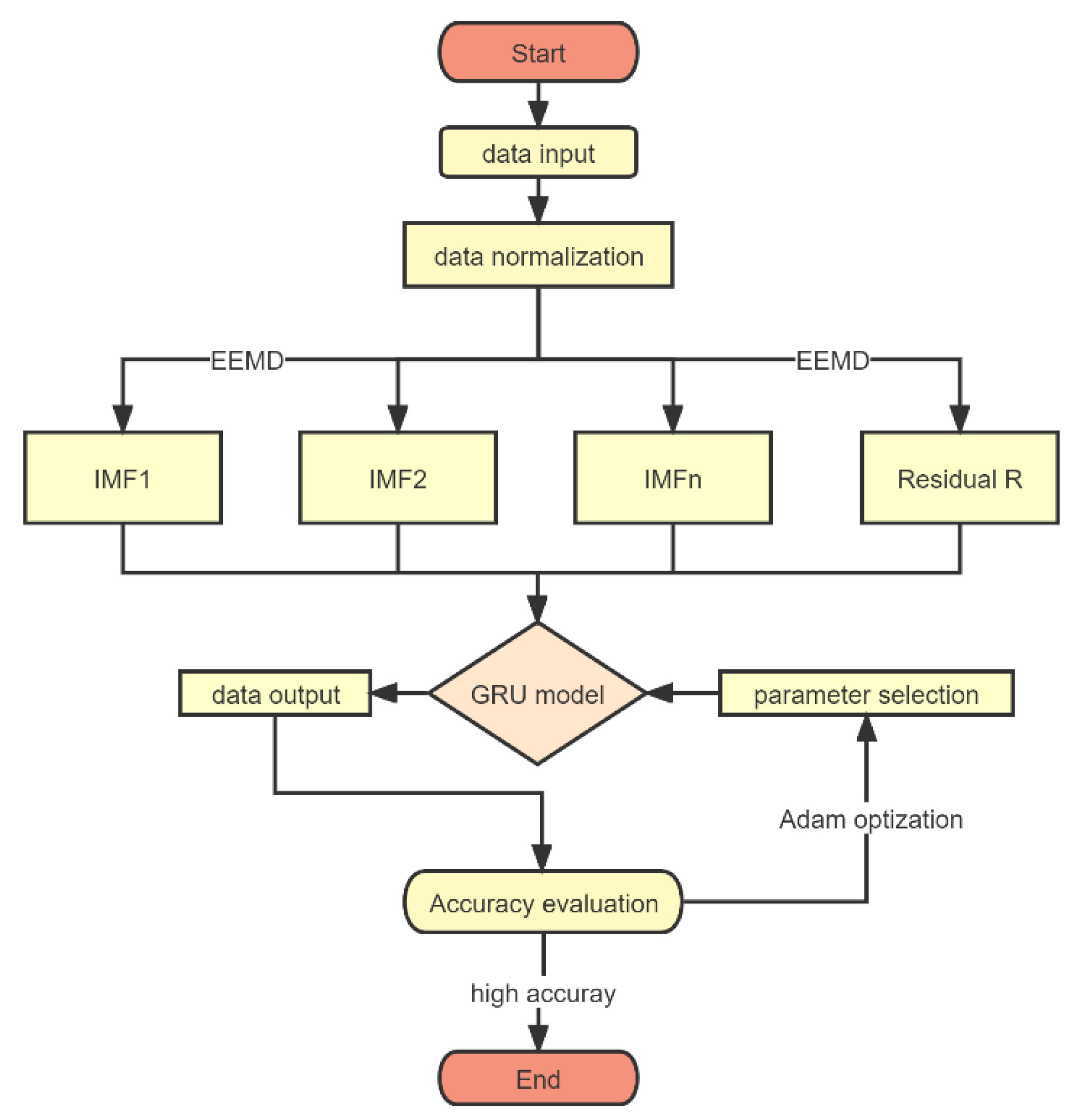

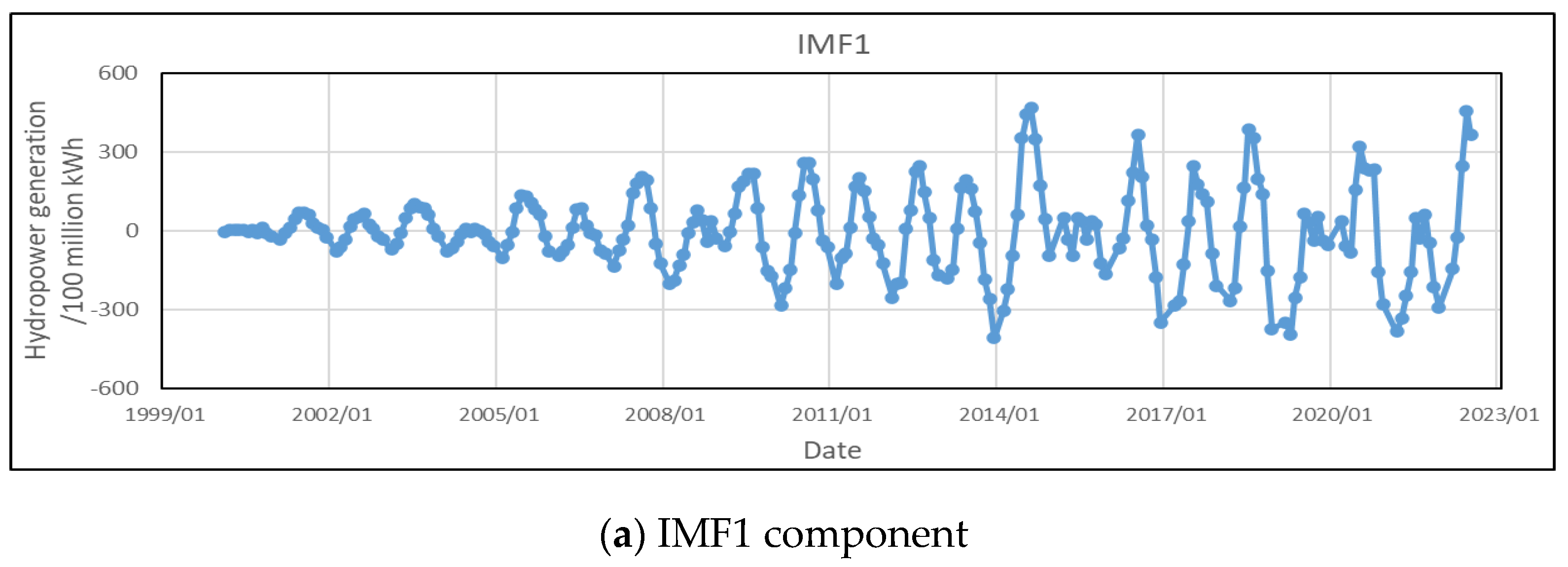
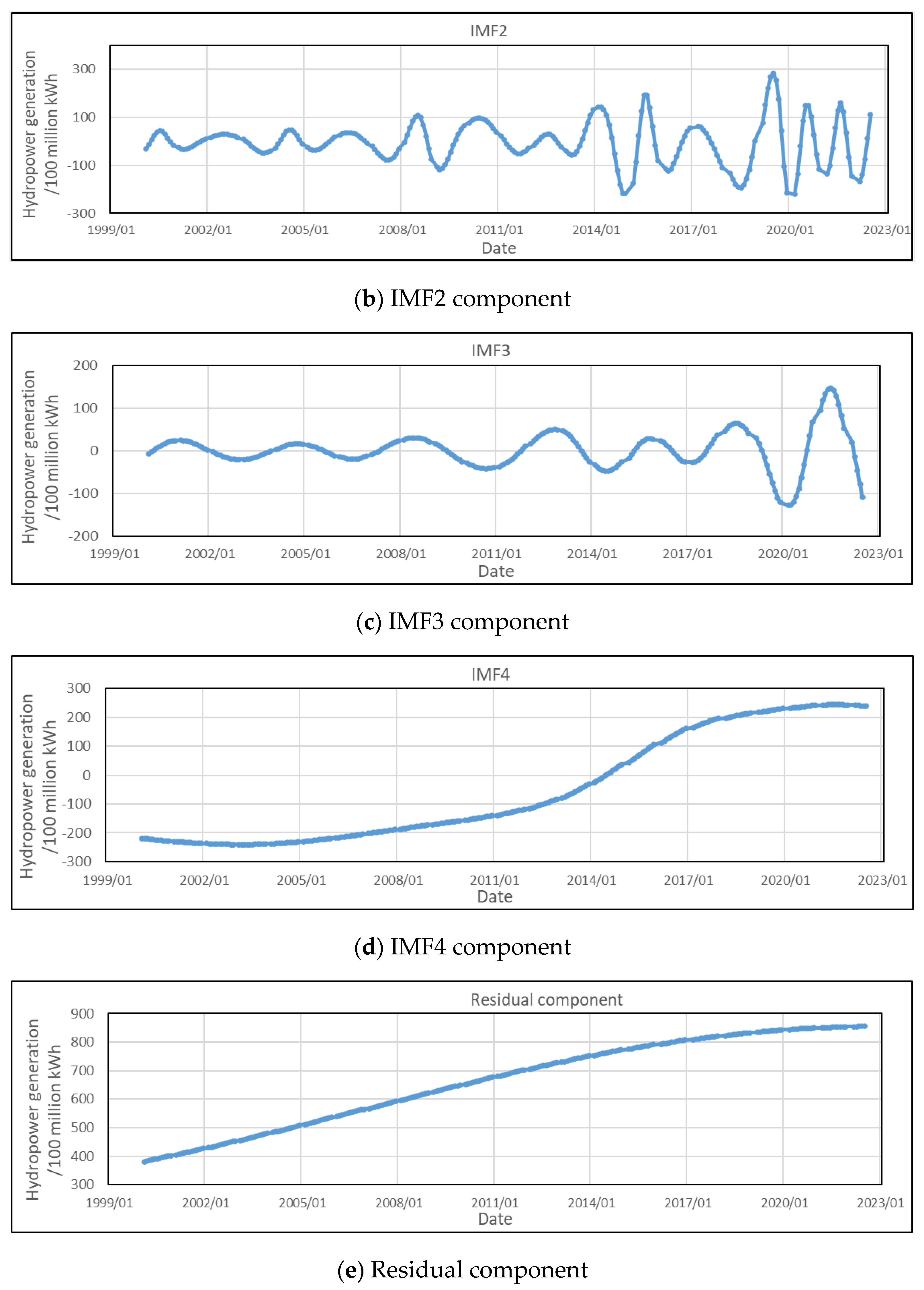
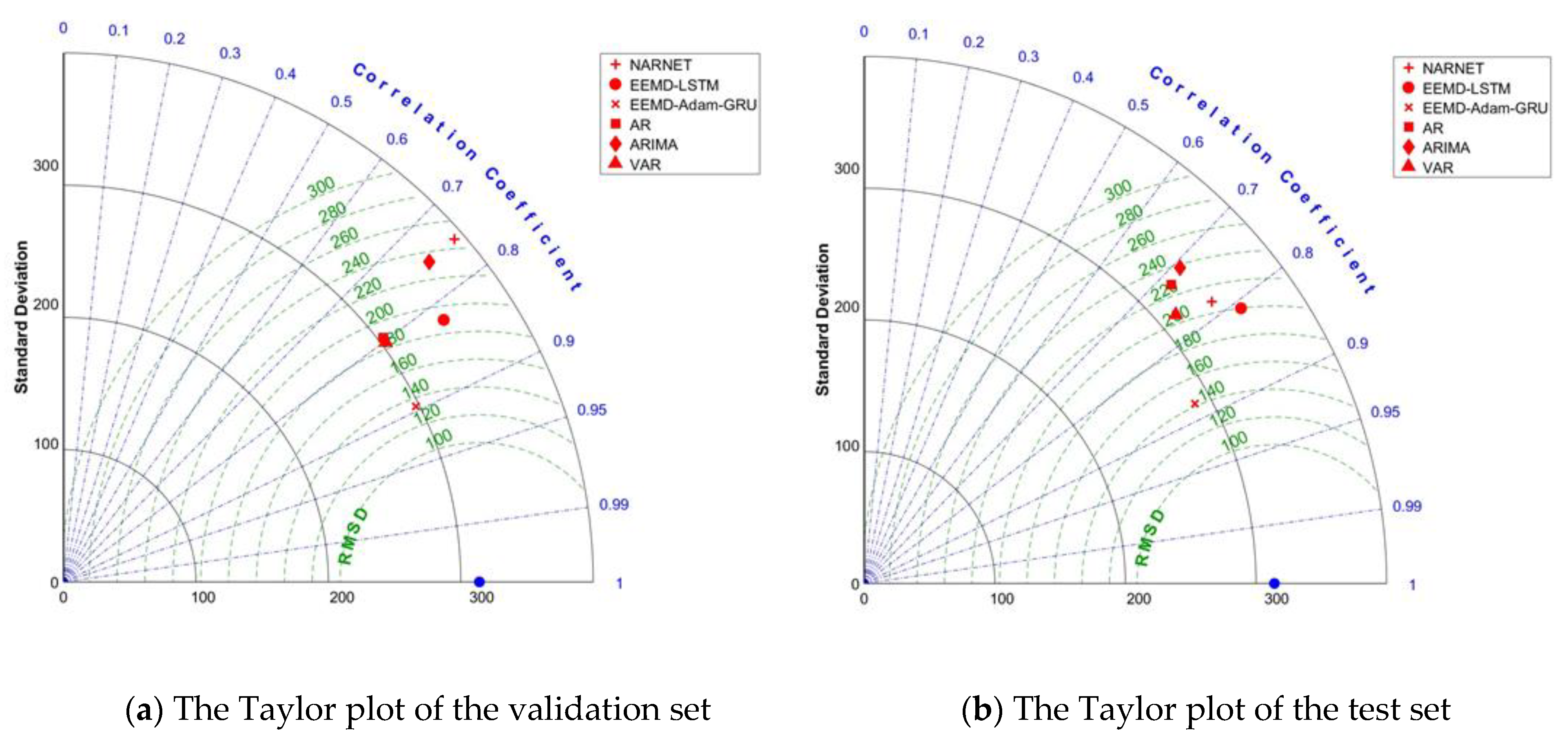
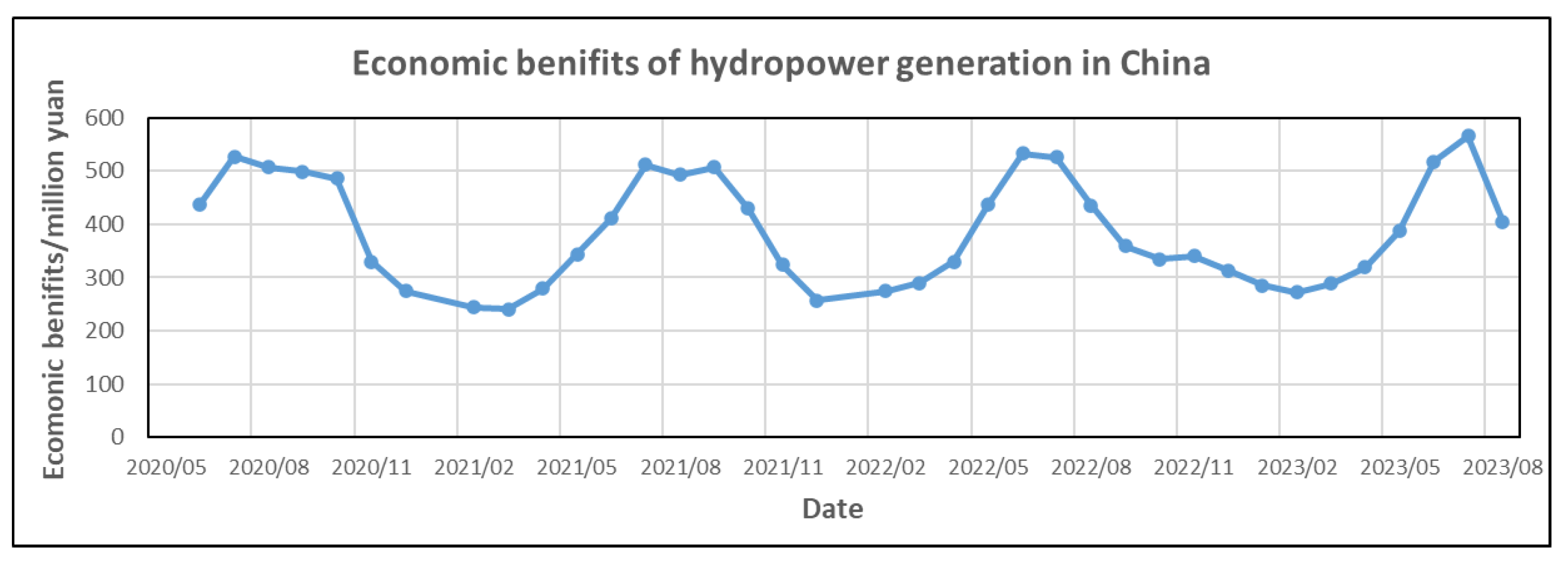
| Parameter | Value | Parameter | Value |
|---|---|---|---|
| Max epochs | 250 | Learn rate schedule | ‘piecewise’ |
| Gradient threshold | 1 | Learn rate drop period | 125 |
| Initial learn rate | 0.0005 | Learn rate drop factor | 0.2 |
| Number of hidden layers | 1 | Number of neurons | 128 |
| Active function | Sigmoid | Dropout | 0.2 |
| Comparison Model | Parameter Title | Value |
|---|---|---|
| NARNET | Number of neurons | 30 |
| Feedback mode | ‘Open’ | |
| Train function | ‘trainlm’ | |
| LSTM | Max epochs | 250 |
| Gradient threshold | 1 | |
| Initial learn rate | 0.0005 | |
| Learn rate schedule | ‘piecewise’ | |
| Learn rate drop period | 125 | |
| Learn rate drop factor | 0.2 | |
| AR | Compound AR polynomial degree | 15 |
| Compound MA polynomial degree | 0 | |
| Degree of nonseasonal integration | 0 | |
| Degree of seasonal differencing polynomial | 0 | |
| ARIMA | Compound AR polynomial degree | 4 |
| Compound MA polynomial degree | 8 | |
| Degree of nonseasonal integration | 1 | |
| Degree of seasonal differencing polynomial | 0 | |
| VAR | Multivariate autoregressive polynomial order | 10 |
| Model | RSME/Billion kWh | Decline Ratio | SD/billion kWh | Decline Ratio |
|---|---|---|---|---|
| NARNET | 179.34 | 16.16% | 324.32 | 15.69% |
| EEMD-LSTM | 189.24 | 20.55% | 338.32 | 19.18% |
| EEMD-ADAM-GRU | 150.35 | / | 273.42 | / |
| AR | 171.04 | 12.10% | 310.43 | 11.92% |
| ARIMA | 183.28 | 17.97% | 323.56 | 15.50% |
| VAR | 163.33 | 7.95% | 298.21 | 8.31% |
Publisher’s Note: MDPI stays neutral with regard to jurisdictional claims in published maps and institutional affiliations. |
© 2022 by the authors. Licensee MDPI, Basel, Switzerland. This article is an open access article distributed under the terms and conditions of the Creative Commons Attribution (CC BY) license (https://creativecommons.org/licenses/by/4.0/).
Share and Cite
Wang, J.; Gao, Z.; Ma, Y. Prediction Model of Hydropower Generation and Its Economic Benefits Based on EEMD-ADAM-GRU Fusion Model. Water 2022, 14, 3896. https://doi.org/10.3390/w14233896
Wang J, Gao Z, Ma Y. Prediction Model of Hydropower Generation and Its Economic Benefits Based on EEMD-ADAM-GRU Fusion Model. Water. 2022; 14(23):3896. https://doi.org/10.3390/w14233896
Chicago/Turabian StyleWang, Jiechen, Zhimei Gao, and Yan Ma. 2022. "Prediction Model of Hydropower Generation and Its Economic Benefits Based on EEMD-ADAM-GRU Fusion Model" Water 14, no. 23: 3896. https://doi.org/10.3390/w14233896
APA StyleWang, J., Gao, Z., & Ma, Y. (2022). Prediction Model of Hydropower Generation and Its Economic Benefits Based on EEMD-ADAM-GRU Fusion Model. Water, 14(23), 3896. https://doi.org/10.3390/w14233896





